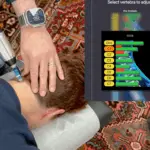Smart Watches Track Data That Chiropractors Can Use
When smart watches were first invented, more than a decade ago, they basically acted like compact cell phones that you’d strap to your wrist. Most also counted basic fitness activity, providing step counts, distances traveled, etc.
But a lot has changed in ten years.
In a recent article on ZDNet, the author explores the possibility of smart watches and other “wearables” being used in emergency rooms to provide live vitals monitoring to nurses and doctors. Sure, there are IT interoperability problems and privacy concerns, but these barriers can be overcome—and perhaps they will be, in the next few years.
In the field of chiropractic, doctors are also seeing smart watch data as a tool that can be used in their practices. In fact, Dynamic Chiropractic recently published their first story (close out of the ad to view the story) in a bi-monthly series about the ways chiropractors can use wearable technology. Chiropractic Economics has also written on the subject.
This is probably obvious, but here at Sense Technology, we really love technology. And we love to watch it evolve and grow. Perhaps, if chiropractors really do start using smart watch data, future PulStars will integrate with them, too? The possibilities are exciting.
But until then, here are some ways that you can use the data contained in these tiny little computers to help put your patients on their journey to wellness.
- Improving Posture: It’s the key to spinal wellness, and there are two tools contained in most smart watches today that help promote better posture—standing and breathing notifications. If you encourage your patients to set goals on their watches in both of these categories, the watch will remind them to stand (and re-align their spines) for at least one minute per hour, and it will also initiate regular breathing exercises (which are completely ineffective while slouching). The watch will track their progress, and then you can talk about it at their next appointment. Added bonus: Any time they initiate a breathing or standing exercise, they’ll think of their thoughtful chiropractor and remember that it might be time to give them a call.
- Wellness Tracking: Like we mentioned before, smart watches are now tracking much more than daily step totals. Many monitor heart rate, provide ECG monitoring, fall detection, health records, blood oxygen levels, hand washing detection, workout tracking and so much more. If your practice offers a particular service—say nutrition counseling—there is likely a smart watch feature to help patients track and monitor their progress (nutrition tracking IS a useful smart watch feature).
- Sleep Hygiene Monitoring: Many smart watches will provide patients with their sleep score or other comparable sleep monitoring data. How many times a week does a patient come into your office and say “I must have slept on it weird?” Well with this data, you can actually confirm that this may be the case. Sleep scores provide information on how long your patient slept, how deeply they slept (how much time they spent in REM sleep) and how restless they were. Once you have this information, you can recommend techniques, exercises and possibly products and supplements to help your patient achieve better sleep scores.
Want to get more tips on ways to improve your practice? Check out our Best of Marketing Bundle to get ideas and tools you can use.











